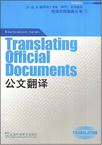公文翻译
出版时间:2008-7 出版社:上海外语教育出版社 作者:罗伯托·马约拉尔·阿森西奥 页数:156
Tag标签:无
内容概要
公文一般是指有效的法律文件,几乎无所不包,从出生证明、死亡证明、结婚证明到学分记录、法律合同等。随着全球化的进程越来越快,各个国家不同文化之间的交流日益密切,尤其是一些公文翻译和认证,变得越来越重要。由于公文的翻译具有较强的特殊性,文化差异表现得十分突出。目前国内外很少有人讨论公文翻译所面临的困惑以及翻译技巧的运用。 作者根据自己丰富的翻译实践经验和翻译教学经验,深入浅出地介绍了公文翻译涉及到的很多实际问题,并在尽可能广泛的文化语境内讨论解决的对策,同时对译者的主动性子以足够的关注。 这本著作可以广泛地用于课堂教学,或供读者自学,还可以供职业人员指导自己的翻泽实践。每一章节都配有建议性的活动和练习,在全书的最后还附有全球职业协会和组织的相关信息。
作者简介
阿森西奥,在西班牙格拉纳达大学执教23年,还是普林斯顿大学、达特茅斯大学和杨百翰大学的访问教授,从事公文翻译长达18年。
书籍目录
1. Introduction2. Professional Practice 2.1 Professional practice around the world 2.2 Features of official translation in different countries and regions3. Social Context 3.1 Participants 3.2 Loyalties 3.3 The translator's ideology 3.4 Across cultural distance4. Documents 4.1 Types 4.2 Information and functions5. The Official Translator as a Jurilinguistic Expert6. Different Ways of Translating 6.1 Adequacy conditions 6.2 Constraints 6.2.1 Legal norms 6.2.2 Ethical norms: Professional vs. personal 6.2.3 Traditions and customs 6.2.4 Constraints imposed by the client, the initiator or the recipient 6.3 Freedom7. Common Problems and Frequent Solutions 7.1 Means of expression 7.2 Format and typing conventions 7.2.1 Belonging to the original vs. belonging to the translation 7.2.2 Converting complex formats into paragraph sequences 7.2.3 Text vs. image 7.2.4 Avoiding deception 7.2.5 One source language 7.2.6 Legibility 7.2.7 Understandability 7.2.8 Originality 7.2.9 Other writing conventions 7.2.10 Translating into different formats 7.3 Validity and execution of documents 7.3.1 Signature and seal 7.3.2 Certifying authorities 7.4 Medium8. On the Translation of Different Documents 8.1 Birth, marriage and death certificates 8.2 Academic transcripts and diplomas 8.3 Agreements and undertakings9. Sources of Information10. Other Professional Aspects 10.1 Fees and estimates 10.2 Professional associationsReferences and Further ReadingAddressesAppendixIndex
章节摘录
7. 3 Validity and execution of documents Official documents must compiy with certain requirements to be valid. Those requirements not only vary from one country to another, they also define differ- ent stages in the life of adocument or set of documents. From the moment a document is initiated in the source culture until we ob- tain a valid translation in a foreign country, we can find the following added documents, illustrated on the basis of two certificates of birth (UK and US) and an academic transcript (See Appendix): Translation process for a birth certificate (United Kingdom Source: 1) The source document is an entry in the Registry, which is not physically included in the documentation. Source text: 2) The first document included in the documentation is the blank birth certificate form. It includes instructions for its completion and in some cultures it may indicate how to correct mistaken information given. As such, this docu- ment is not included in the documentation for official translation. 3) The next document is the blank birth certificate form that has been completed and validated by the Registrar of Births and Deaths. This document is legally valid in the source country but not in Spain. Transition text: 4) The completed form is followed by the birth certificate that is authenticated by the Foreign Office s Hague Apostille. This recognition is usually a blank text that must be completed. In Spain, the official translation will not be valid unless the source document carries the compulsory Hague Apostille.
编辑推荐
本书是西班牙格拉纳达大学教授,根据其23年的丰富翻译实践经验和翻译教学经验所编写而成的,全书深入浅出地介绍了公文翻译涉及到的很多实际问题,并且在尽可能广泛的文化语境内讨论解决的对策,同时对译者的主动性予以足够的关注。每一章节都配有建议性的活动和练习,在全书的最后还附有全球职业协会和组织的相关信息。这本著作可以广泛地用于翻译课堂教学,或供读者自学,还可以供职业人员指导自己的翻译实践。
图书封面
图书标签Tags
无
评论、评分、阅读与下载
用户评论 (总计9条)
- 专业的内容,还是挺有用的,收着慢慢看。
- 看起来稍有难度。
- 对于学笔译很有用!!!封面很老了,旧旧的,而且里面的印刷有些很模糊,确定是盗版!!!
- 好东西,就是有点贵
- 对笔译很有帮助!!!
- 书很好,至少比我在淘宝在买的复印版的书好太多了。
- Worth re*****, very practical and down to earth.
- 引进版 很好
- 这是一本外国人写的书的原版,并没有讨论中文公文译成外文的方法。原以为是讲中英文翻译的,收到书一看,全是英文的,论述公文中译英的具体翻译方法一点也没有。多少有点失望。
推荐图书
- 新中考英语单项选择与情景交际训练
- 新中考英语书面表达180篇
- 新中考英语语法强化训练
- 河南省地质灾害防治手册
- 土石坝施工质量控制技术
- 超弦理论(第2卷)
- 线性代数
- 中外民间故事
- 一千零一夜
- 动物产品安全生产与卫生学
- 小学生课外阅读必读丛书1
- 学习与评价课课练
- 现代企业经营管理
- 电子商务基础
- 物流管理基础与实务
- 畜产品质量安全与生产技术
- 有机化学学习指导
- 药用植物病虫害防治
- 美人茶饮
- 美人食材
- 北大绿卡·新课标教材课时同步讲练
- 北大绿卡新课标教材课时同步讲练:高中地理(必修2)(湖南教育版)
- 北大绿卡新课标教材课时同步讲练:高中地理(必修3)(湖南教育版)
- 北大绿卡新课标教材课时同步讲练:高中语文(必修5)(江苏教育版)
- 北大绿卡:高中思想政治(必修4)(人教版新课标教材课时同步讲练) (平装)
